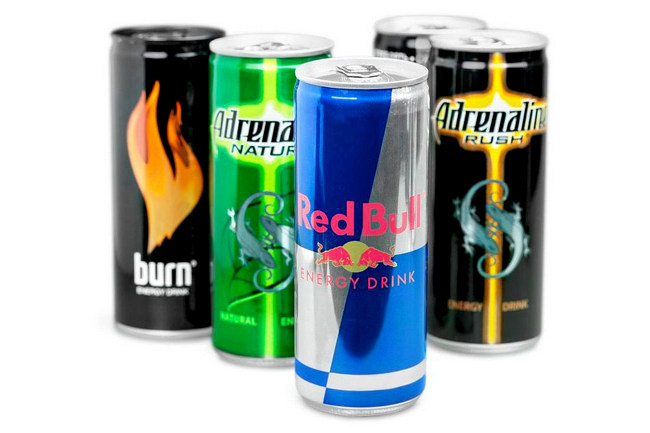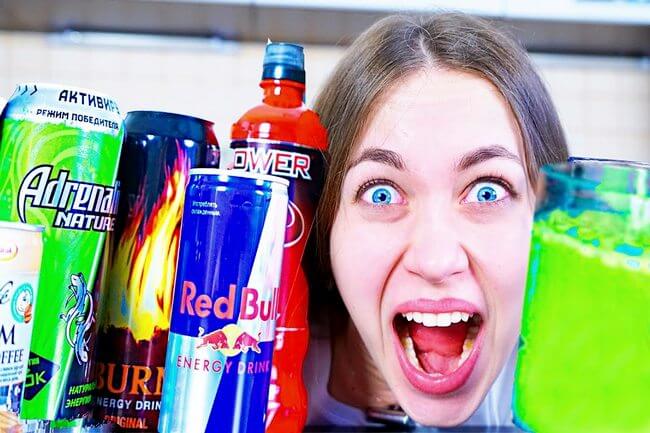Energy drinks—that’s what beverages with invigorating powers are called, which are indeed very popular. Students, who stay up late to prepare for an exam; young people, hanging out in clubs; truck drivers who go on long-distance missions; security guards, watchmen, and other round-the-clock professions; those who go to the gym after a hard day at work—this by far is not the full list of consumers.
Despite the fact that the media often sound an alarm about the harmful effects of energy drinks on the body, they still hold leading positions in sales. What do they have more—benefits or harm?
General information

Energy drinks are beverages with a pronounced tonic, antisedative effect due to the content of natural psychostimulants. It is recommended that you use them for a quick recovery of strength, relief from fatigue, and drowsiness. They are in the highest demand among those who need to stay awake or double their energy level for several hours.
Many believe that they are a discovery of the 21st century, but, alas, it is not true. In fact, their analogues can be found in the works of ancient herbalists. For example, one of the books by the famous German abbess Hildegard von Bingen (12th century) contains a recipe for an elixir that adds vigor.
In the form that we know today, they began to appear about a century ago. In 1927, Lucozade was created in the UK for the accelerated recovery of patients with a composition typical of modern energy drinks: carbon dioxide, glucose syrup, citric and lactic acids, caffeine, sodium benzoate and bisulfate, vitamin B9.
On its basis, a new drink Lipovitan was created in Japan in 1962, which began to be sold not as a drug for accelerated recovery, but as a stimulating drink that prevents falling asleep for several hours and provides a surge of strength and vigor. Since that time, the production of energy drinks in the East was put onstream.
This was initiated in Europe by Austrian entrepreneur Dietrich Mateschitz, who borrowed the recipe while vacationing in Hong Kong. Having added to it modern, more advanced components, he created a completely new product, Red Bull, which eventually made him one of the richest people on the planet. The brand has a scandalous reputation, but it is still incredibly popular all over the world.
In 1985, energy drinks conquered America, thanks to Jolt Cola, which was recommended for use by students and people engaged in professional activities requiring prolonged mental and physical exertion. In 1995, Jolt was replaced by Josta from PepsiCo, on the basis of which Adrenaline Rush began to be produced since 1999.
In New Zealand and Australia, Frucor Beverages is taking the lead.
The sales volume today exceeds 50 billion dollars.
Many people are interested in the question of the minimum age for selling energy drinks. If they do not contain alcohol, on the territory of the Russian Federation they can be freely sold to people of any age, including children and adolescents. The legislation does not prohibit this. The only exception is the Moscow region, where the sale of such beverages to minors has been prohibited since May 1, 2015.
Effects on the body
Since the launch of mass production of energy drinks, they have been constantly arguing about how they affect human health. In order to figure out what in them is greater—benefit or harm, it is necessary to know on which systems and organs they act and how.
Properties:
- stimulating—increase muscle tone, ensuring a prolonged state of CNS and muscle tissue excitation without fatigue;
- stimulate the central nervous system—increase its activity, accelerate functioning;
- provide an antisedative effect—relieve drowsiness and lethargy, invigorate, and prevent falling asleep.

Due to these properties, within 2-4 hours after drinking the beverage (the duration of the effect depends on the individual characteristics of the body):
- mood rises sharply, up to a state of euphoria;
- a surge of strength, cheerfulness, and energy is observed;
- there is no desire to sleep;
- efficiency increases;
- indicators of strength and endurance improve;
- thinking becomes more active;
- the desire for physical activity increases.
A person experiences all this within 5-10 minutes after drinking the drink. However, there is also a downside to this coin.
It seems to everyone that energy drinks themselves are a source of energy. This is a delusion. The active substances that make up them are stimulants that work according to a simple scheme: they are quickly absorbed into the bloodstream, excite the nervous system, forcing the body to spend its own energy in double doses, and only then transfer energy to the cells. That is, they do not supply it, but, on the contrary, take it away from the person in large quantities.
An illustrative example for comparison. A loader must unload 4 wagons during an 8-hour working day. He can do it even by evenly distributing the load—1 wagon in 2 hours. In this case, he will take breaks for rest and eventually feel only slight fatigue at the end of the shift. However, there is another way: to unload all 4 wagons in 2 hours, working at an accelerated pace, without recovering strength. As a result, he will deplete all his body’s reserves and will feel bad by the end of the second hour.
The same thing happens with the body, which, in its normal state, evenly distributes the available energy. Energy drinks force it to spend all of it within a short period of time. It is easy to guess what will happen after the effect ends: exhaustion, loss of strength, poor health—and this is far from everything that will have to be experienced after a surge of euphoria.
Thus, the effect of energy drinks on the human body is a vivid example of a double-edged sword. On the one hand, there is a surge of strength and an incredible surge of energy, when it seems that you can easily move mountains. But after a few hours, there is a complete depletion of the body and nervous system.
Composition
The effect on the body of energy drinks is determined by the active substances that are included in their composition. For almost all brands with minor variations, the basis is the same.
The main active ingredients:
- glucose—the main “extractor” of energy from the body;
- taurine—an amino acid that accelerates energy processes in the body;
- caffeine—a psychotropic alkaloid that activates the nervous and cardiac activity, accelerates the heart rate, dilates blood vessels, increases intellectual and physical performance, and eliminates drowsiness;
- guarana—a vine, the extract of which contains a large amount of caffeine, increases mood, and invigorates;
- ginseng—a natural psychostimulant;
- nicotinic acid (vitamin B3) stabilizes the functioning of the nervous system;
- pantothenic acid (B5) takes part in the restoration of nerve tissues;
- pyridoxine (B6) has a regulating effect on the nervous system;
- folic acid (B9) increases the production of serotonin and norepinephrine in the body, which increase mood;
- ascorbic acid (C) ensures the delivery of glucose to the destination, takes part in the production of serotonin.
This is not counting preservatives, colorants, and carbonic acid, which makes them carbonated. Caffeine and glucose are indispensable ingredients. Taurine is found in 75% of drinks.
At first glance, the composition may seem balanced: some substances activate the nervous system, while others, on the contrary, calm and stabilize it. In reality, the former are several times greater than the latter. Manufacturers use only 1-2 vitamins, and in minimal quantities.
Harm
Why is it constantly discussed in the media that energy drinks are dangerous? At one time (2009-2010), Red Bull was banned in a number of countries due to the fact that, supposedly, it contained elements of cocaine. The examination later refuted this fact, but a wave of indignation and protest was already raised.
